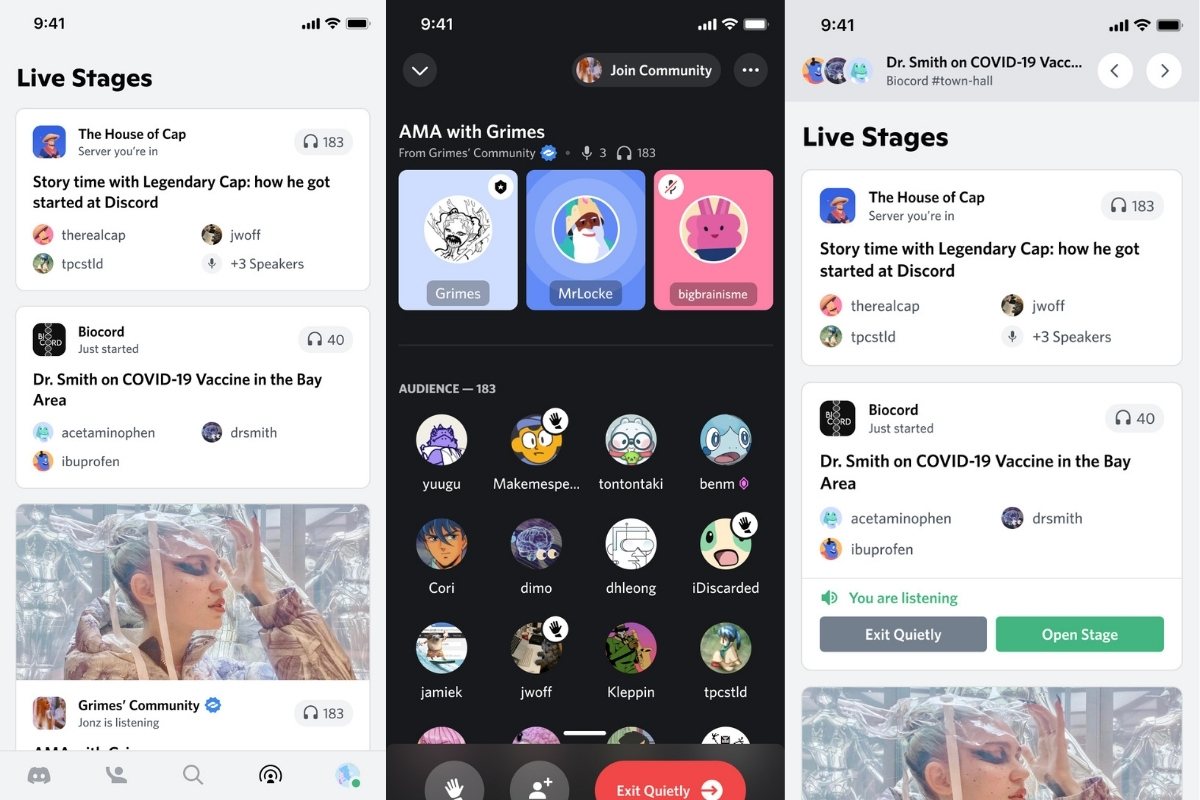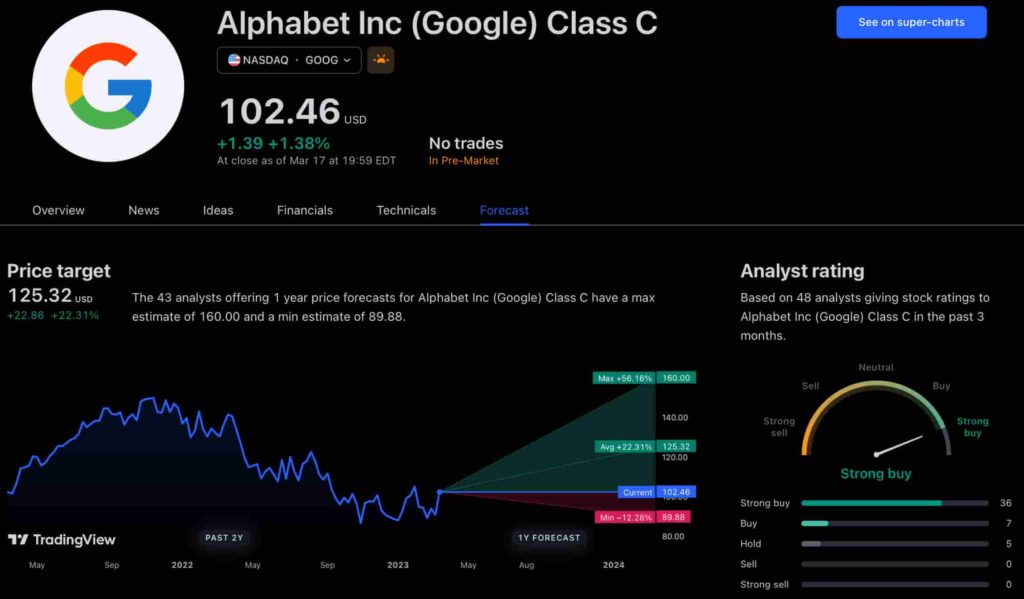The new app is called watchGPT and as I tipped off already, it gives you access to ChatGPT from your Apple Watch. Now the $10,000 question (or more accurately the $3.99 question, as that is the one-time cost of the app) is why having ChatGPT on your wrist is remotely necessary, so let’s dive into what exactly the app can do.
NEWS
Discord’s new Stage Discovery portal will connect live audio events with communities

If you’re new to Discord, you might be thrown off by the lack of an endless feed peppered with ads. On Discord, all of the action happens in interest-specific servers, and the company wants to make it easier for anyone to stumble across and plunge into those communities.
The company launched Stage Channels, its own Clubhouse-like voice event rooms, in late March. With those building blocks in place, in June Discord will start surfacing events (think open mic nights, book clubs, etc.) through a new portal called Stage Discovery, adding a way for anybody to connect with the cool communities in the process.
Discord Product Manager Rick Ling says Stage Channels are a hit so far, and the company realized that events can be a gateway to introduce new users to the communities at the heart of the platform.
“For us, just dropping in and out of these audio conversations is not the end goal,” Ling said during a press event. Soon, servers will be able to list public events, inviting anybody to come check things out. Discord also says that its new discovery feature will launch with some noteworthy partners, hinting that “one rhymes with…… rhymes.” (It’s Grimes.)

Discord has a few other new features around the corner too. Threaded conversations are on the way this summer and the company is about to begin a pilot program to test paid, ticketed audio events. The latter could be a huge boon for creators, who haven’t been able to make money through the platform previously, and an important extra revenue stream for a platform that has no plans to get into the targeted advertising game.
Discord is obviously taking notes from Clubhouse here — live audio event discovery is Clubhouse’s whole thing — but Discord’s deep well of interest-based communities stands to push its own experience far beyond what the newer audio upstart can offer. The company has a five year head start and universal brand recognition with young people: most of its 150 million monthly active users are the 18-24 year-olds who comprise a big chunk of Gen Z.
Discord doesn’t really need to compete with Clubhouse — in many ways, it was there first. The company might have cribbed some smart features along with everybody else, but Clubhouse’s downloads are falling off a cliff and the latter app probably needs to prove it can compete with Discord and more entrenched social networks at this point.

Discord’s next evolution
Stage Discovery is a bit of a departure for Discord. Previously, to check out a live event, you needed to pop into a server first. Because the platform is so community-based, people interested in a topic, say a particular Twitch streamer, often hop directly into those servers from elsewhere. Discord does have some discovery and search functionality — users can thumb through popular and featured public servers in its Discover tab — but historically it’s been relatively basic. But by expanding the “discovery surface,” Discord is likely to attract a lot of people who either haven’t heard of the app or think it’s just a voice chat utility for gamers.
Discord’s new discovery feature will show up in the home tab, offering a directory of live voice events. The feature’s real promise is that those events can bring new users into the fold, connecting them to thriving communities that have a lot more going on beyond events. Users will be able to see voice events at which their friends are hanging, events that servers they belong to are hosting and other live events that they aren’t connected to.
“At the end of the day, this is still really a window into communities and how to join communities,” Discord Product Marketing spokesperson Jesse Wofford told TechCrunch. Wofford emphasized that Discord isn’t trying to lure anybody into an endless scrolling loop — instead the goal is connecting users with the vibrant communities for which the platform is known.
Discord is also celebrating its sixth birthday by sprucing up its brand a little, brightening its color scheme and making a few tweaks to its apparently beloved anthropomorphized little purple controller dude, Clyde. (Discord insists that Clyde is “blurple.”) The company says it wants to keep things playful while making its visual identity “more inclusive and welcoming” to the kind of people who haven’t been using the app for years.

While a big boost to discovery is on the near horizon, Discord’s product philosophy hasn’t changed. “There are no feeds, no likes, no way for anything to go viral,” Discord founder and CEO Jason Citron said, adding that Discord was designed with community building in mind from day one.
Discord wasn’t always such a welcoming place. The app has always served gamers, but it was also a haven for white supremacists, including the ones who organized the Charlottesville rally that left Heather Heyer dead. In a not-so-distant past life, dangerous far-right extremism thrived on Discord, even as the company largely avoided the bad headlines that slammed more mainstream social platforms for facilitating hate.
Discord rooted out neo-Nazis and other dangerous communities starting in 2017, and by 2021 the company was well-positioned to tell a different story. Now, 15% of the company works on its Trust and Safety team, a group dedicated to protecting users and shaping content moderation policies. The product was built for gamers from the get-go, but Discord has been broadening its horizons recently and started having conversations with users about how it’s helped them fight isolation during the pandemic.
The company’s aspirations ultimately go well beyond the gaming community. Unlike Instagram’s ad-choked social feed or Twitter’s often brain-melting endless loop, Discord remains a joy to use. And all of that user-friendliness doesn’t appear to be a bait and switch either. Revenue from its Nitro premium product and other paid perks are growing fast and the company has no plans for targeted ads.
Discord’s savvy pandemic-era campaign to broaden its appeal to nongaming communities — musicians, study groups, surrealist fantasy baseball leagues — appears to be paying off. Discord’s user numbers are explosive and it’s been adding sensible new features at a healthy clip. The outlook is good for the company and its users alike, and what a rare convergence that is.
Facebook Faces Yet Another Outage: Platform Encounters Technical Issues Again

Uppdated: It seems that today’s issues with Facebook haven’t affected as many users as the last time. A smaller group of people appears to be impacted this time around, which is a relief compared to the larger incident before. Nevertheless, it’s still frustrating for those affected, and hopefully, the issues will be resolved soon by the Facebook team.
Facebook had another problem today (March 20, 2024). According to Downdetector, a website that shows when other websites are not working, many people had trouble using Facebook.
This isn’t the first time Facebook has had issues. Just a little while ago, there was another problem that stopped people from using the site. Today, when people tried to use Facebook, it didn’t work like it should. People couldn’t see their friends’ posts, and sometimes the website wouldn’t even load.
Downdetector, which watches out for problems on websites, showed that lots of people were having trouble with Facebook. People from all over the world said they couldn’t use the site, and they were not happy about it.
When websites like Facebook have problems, it affects a lot of people. It’s not just about not being able to see posts or chat with friends. It can also impact businesses that use Facebook to reach customers.
Since Facebook owns Messenger and Instagram, the problems with Facebook also meant that people had trouble using these apps. It made the situation even more frustrating for many users, who rely on these apps to stay connected with others.
During this recent problem, one thing is obvious: the internet is always changing, and even big websites like Facebook can have problems. While people wait for Facebook to fix the issue, it shows us how easily things online can go wrong. It’s a good reminder that we should have backup plans for staying connected online, just in case something like this happens again.
NEWS
We asked ChatGPT what will be Google (GOOG) stock price for 2030

Investors who have invested in Alphabet Inc. (NASDAQ: GOOG) stock have reaped significant benefits from the company’s robust financial performance over the last five years. Google’s dominance in the online advertising market has been a key driver of the company’s consistent revenue growth and impressive profit margins.
In addition, Google has expanded its operations into related fields such as cloud computing and artificial intelligence. These areas show great promise as future growth drivers, making them increasingly attractive to investors. Notably, Alphabet’s stock price has been rising due to investor interest in the company’s recent initiatives in the fast-developing field of artificial intelligence (AI), adding generative AI features to Gmail and Google Docs.
However, when it comes to predicting the future pricing of a corporation like Google, there are many factors to consider. With this in mind, Finbold turned to the artificial intelligence tool ChatGPT to suggest a likely pricing range for GOOG stock by 2030. Although the tool was unable to give a definitive price range, it did note the following:
“Over the long term, Google has a track record of strong financial performance and has shown an ability to adapt to changing market conditions. As such, it’s reasonable to expect that Google’s stock price may continue to appreciate over time.”
GOOG stock price prediction
While attempting to estimate the price range of future transactions, it is essential to consider a variety of measures in addition to the AI chat tool, which includes deep learning algorithms and stock market experts.
Finbold collected forecasts provided by CoinPriceForecast, a finance prediction tool that utilizes machine self-learning technology, to anticipate Google stock price by the end of 2030 to compare with ChatGPT’s projection.
According to the most recent long-term estimate, which Finbold obtained on March 20, the price of Google will rise beyond $200 in 2030 and touch $247 by the end of the year, which would indicate a 141% gain from today to the end of the year.
Google has been assigned a recommendation of ‘strong buy’ by the majority of analysts working on Wall Street for a more near-term time frame. Significantly, 36 analysts of the 48 have recommended a “strong buy,” while seven people have advocated a “buy.” The remaining five analysts had given a ‘hold’ rating.

The average price projection for Alphabet stock over the last three months has been $125.32; this objective represents a 22.31% upside from its current price. It’s interesting to note that the maximum price forecast for the next year is $160, representing a gain of 56.16% from the stock’s current price of $102.46.
While the outlook for Google stock may be positive, it’s important to keep in mind that some potential challenges and risks could impact its performance, including competition from ChatGPT itself, which could affect Google’s price.
Disclaimer: The content on this site should not be considered investment advice. Investing is speculative. When investing, your capital is at risk.
NEWS
This Apple Watch app brings ChatGPT to your wrist — here’s why you want it

ChatGPT feels like it is everywhere at the moment; the AI-powered tool is rapidly starting to feel like internet connected home devices where you are left wondering if your flower pot really needed Bluetooth. However, after hearing about a new Apple Watch app that brings ChatGPT to your favorite wrist computer, I’m actually convinced this one is worth checking out.
-

 PPC4 days ago
PPC4 days ago19 Best SEO Tools in 2024 (For Every Use Case)
-

 MARKETING7 days ago
MARKETING7 days agoWill Google Buy HubSpot? | Content Marketing Institute
-
SEARCHENGINES7 days ago
Daily Search Forum Recap: April 16, 2024
-

 SEO7 days ago
SEO7 days agoGoogle Clarifies Vacation Rental Structured Data
-

 MARKETING6 days ago
MARKETING6 days agoStreamlining Processes for Increased Efficiency and Results
-
SEARCHENGINES6 days ago
Daily Search Forum Recap: April 17, 2024
-

 SEO6 days ago
SEO6 days agoAn In-Depth Guide And Best Practices For Mobile SEO
-

 PPC6 days ago
PPC6 days ago97 Marvelous May Content Ideas for Blog Posts, Videos, & More














